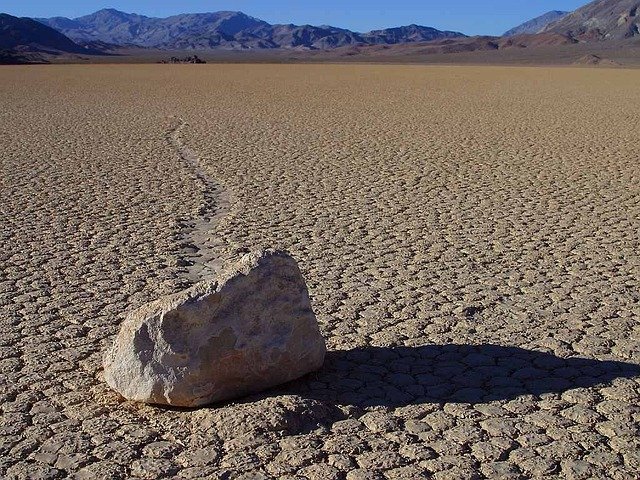Where the Bleep Can Rocks Move by Themselves?
The Bleeping Mystery of Death Valley’s Sailing Stones
It sounds like something straight out of a sci-fi movie: rocks moving across the desert floor all by themselves, leaving long, winding tracks behind them. But this isn’t a case of paranormal activity or alien interference—it’s a real phenomenon known as the “sailing stones” of Death Valley, California.
What the Bleep Are Sailing Stones?
Sailing stones, also called sliding rocks, are a natural mystery found on the dry lake bed known as Racetrack Playa in Death Valley National Park. These rocks, some weighing as much as 700 pounds (318 kg), appear to move across the flat, dry surface without any apparent external force, leaving behind long, shallow furrows in the dirt.
For decades, people have been baffled by these rocks, wondering how they could possibly move on their own. Without any evidence of human or animal interference, the sailing stones have puzzled geologists and intrigued visitors for years.
How the Bleep Do These Rocks Move?
The movement of these rocks was a complete mystery until recently, when scientists finally figured out the conditions needed to set these stones in motion. Here’s what the latest research reveals:
- Thin Ice Formation: During cold winter nights, a thin layer of ice forms on the playa surface. This ice, just a few millimeters thick, begins to crack and break up as it warms up in the morning sun.
- Water and Ice Interaction: As the ice melts under the desert sun, it creates a slick layer of water on top of the playa’s muddy surface. This thin film of water reduces friction between the rocks and the ground, making it easier for the stones to slide.
- Wind Power: Strong winds blow across the flat, open playa, pushing against the rocks. With the slippery surface created by the melting ice, even light winds can be enough to move the rocks, sending them sliding across the lake bed.
- Slow and Steady: The rocks don’t move quickly—in fact, their movement is often imperceptible to the naked eye. Over time, as the wind continues to blow, the rocks can travel several hundred feet, leaving behind a track that shows their path.
Why the Bleep Did It Take So Long to Solve This Mystery?
While this explanation seems straightforward, it actually took decades for scientists to piece together the puzzle of the sailing stones. Here’s why:
- Remote Location: Racetrack Playa is located in one of the most remote parts of Death Valley National Park, making it difficult for researchers to conduct frequent, on-site studies. Accessing the playa requires a long drive over rough, unpaved roads, which has limited the number of researchers who could study the phenomenon up close.
- Infrequent Events: The specific conditions required for the stones to move don’t happen often. The thin ice layer, coupled with just the right amount of water and wind, is a rare occurrence. Many of the rocks move only once every two or three years, making it hard to observe the process in real time.
- Technological Limitations: Until recently, the technology needed to monitor the stones’ movements wasn’t available. It wasn’t until researchers installed time-lapse cameras and GPS tracking devices on some of the rocks that they could see exactly how the stones were moving.
What the Bleep Can We Learn from the Sailing Stones?
The sailing stones of Death Valley are a perfect example of how nature can still surprise us, even in the age of advanced science and technology. They show that there are still mysteries in the natural world waiting to be uncovered and that sometimes, the simplest explanation—a combination of ice, water, and wind—can explain even the most puzzling phenomena.
The sailing stones also remind us of the importance of patience and perseverance in scientific discovery. It took decades of observation, experimentation, and the right technology to solve this mystery, highlighting the value of continued curiosity and exploration in understanding the world around us.
Where the Bleep Can You See This Phenomenon?
If you’re keen to witness the sailing stones yourself, you’ll need to head to Racetrack Playa in Death Valley National Park. Here are a few tips for your visit:
- Plan Your Trip: The best time to visit Death Valley is during the cooler months of fall, winter, or early spring. Summer temperatures can exceed 120°F (49°C), making it dangerous for travel.
- Get the Right Vehicle: Reaching Racetrack Playa requires driving on rough, unpaved roads. A high-clearance, four-wheel-drive vehicle is recommended to navigate the terrain safely.
- Be Prepared: Death Valley is a remote and extreme environment. Bring plenty of water, food, and supplies, and let someone know your travel plans before heading out.
- Respect the Environment: Racetrack Playa is a protected area, and it’s important to leave no trace. Don’t move the rocks or disturb the tracks they leave behind, as this can damage the delicate environment and disrupt ongoing research.
Why the Bleep Are We Fascinated by the Sailing Stones?
The sailing stones captivate our imaginations because they challenge our understanding of the natural world. They’re a reminder that even the most ordinary objects—a simple rock, in this case—can hold secrets and mysteries that are just waiting to be discovered.
These moving rocks also spark our curiosity and our desire to explore. They encourage us to ask questions, investigate, and seek out answers, showing that the spirit of discovery is alive and well, even in a world where it sometimes feels like everything has already been explained.
So, the next time you hear about something strange or inexplicable, remember the sailing stones of Death Valley and know that sometimes, the truth is just waiting for someone to uncover it. Nature still holds many surprises, and it’s up to us to keep asking, “Where the bleep did that come from?”
The sailing stones of Death Valley are a natural wonder that showcase the power of nature and the complexity of our world. This rare phenomenon demonstrates how seemingly lifeless objects like rocks can tell stories of movement and mystery, reminding us to stay curious and always explore the unknown.

